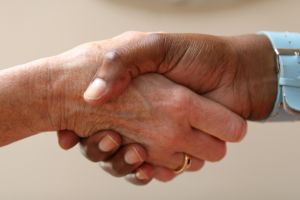A newcomer to Raleigh sooner or later comes up against a riddle: How can the city have two First Baptist Churches?
Here’s a non-surprise: The answer is rooted in the history of a community in which, just as elsewhere throughout the South, white citizens did not mix on equal terms with their black neighbors, whom they regarded as their inferiors. Indeed, for long decades most of those African-Americans were enslaved.
Today, the two First Baptist churches of Raleigh see themselves in some sense as a unified congregation, although they maintain separate staffs, programs and houses of worship. That concept of unification hearkens back to their founding – as one church, with members both black and white, way back in 1812.
It was due to the traumas of secession, the Civil War, reconstruction and Jim Crow that the congregations went their separate ways. Physically, though, the distance between them remained minimal. The historically white First Baptist Church is located on Salisbury Street, directly across from Union Square and the west front of the old state Capitol. Its black “twin,” if it can be called that, is a stone’s throw away, on Wilmington Street kitty-corner from the square. Both church facilities are dignified, attractive and ones in which their members take justifiable pride.
It would have been easy to continue along the separate paths their congregations followed for most the 20th century. But enlightened leaders have resolved to come to terms with the forces that drove them apart – forces that typified the racial divide not only within religious circles but also within American society as a whole. The churches’ location at the very heart of North Carolina’s capital city gives symbolic weight to their effort.
Paths come together
It was in this spirit of racial dialogue and reconciliation that both churches on Feb. 23 hosted a gathering with Taylor Branch, prize-winning historian of the modern civil rights movement. The event resonated with themes broadly applicable in a society where the racial divide persists, if not legally as it once did but in attitudes and expectations.
As Branch put it, these were “two churches getting together in the shadow of the state Capitol to discuss how their history should inform our future.”
Members of both congregations turned out for the Sunday afternoon gathering in the stately sanctuary of First Baptist, Salisbury Street, and the general public was invited as well. Dr. Christopher Chapman, pastor at the host church, set the tone by recounting the history of the two institutions, now reaching out to one another again, and by reminding the audience of the stark social and economic disparities that still exist between whites and blacks – “a legacy of slavery and Jim Crow.” His Wilmington Street counterpart, Dr. Dumas Harshaw, moderated the discussion that followed Branch’s remarks.
Branch, a Baltimore native who now lives there, spent growing-up years in Atlanta before coming to UNC-Chapel Hill as a Morehead Scholar. Atlanta was of course where Martin Luther King Jr. was based during his time as the country’s pre-eminent civil rights leader, and Branch’s epic account of the civil rights movement is framed as a history of “America in the King Years” as well as a King biography. King’s commitment to non-violence embraced a principle at the core of both Christianity and democracy, Branch told his audience.
As hard as it may be to put the doctrine of non-violence into practice – especially, as Branch noted, when our leaders are tempted to use military force to address national challenges — the Christian duty to love one’s enemies and to turn the other cheek comes straight from the Sermon on the Mount. King was resolute in his insistence that civil rights campaigning not take a violent turn.
By the same token, in Branch’s view, non-violence is a key characteristic of democracy, given that ultimate political power resides with voters peaceably casting their ballots. He held up the Freedom Rides – efforts to overcome barriers to black voting in the segregated South, in which some activists were beaten or even killed – as a memorable fusion: “That’s non-violence, that’s democracy, that’s Christianity in its finest sense.”
Just as held true during the King era, Branch suggested, talking about issues of race and confronting the social ills that continue to afflict racial minorities are among Christians’ ongoing responsibilities. To further the racial dialogue, he said, “Churches need to take more risks. Get out and experience. Get out of your comfort zone, and then come back and talk.”
Movement’s momentum
Branch asserted that while few people want to acknowledge it, the partisan gridlock besetting Washington and reaching into state capitals has a racial underpinning. That makes it even more important to keep the race conversation going, with an eye toward closing the gaps in those measures of well-being by which black Americans still on the average trail their white peers.
Nor should the civil rights movement be seen as a chapter of history that’s been closed, Branch said. It should be seen as something that’s evolving – a means toward progress not only for black citizens but also for other groups that have struggled to realize equal treatment under the law.
Today’s most pressing civil rights challenge comes perhaps in the arena of voting rights. In North Carolina, for example, election law changes threaten to hinder black voters who lack photo identification or who have relied on an expansive early-voting period. Branch underscored the Christian perspective by comparing the “equality of votes” to the “equality of souls.”
The federal Voting Rights Act has been weakened by court decisions, but that makes it only more important to update it so that it remains relevant, Branch suggested.
“We need a Voting Rights Act for the future,” he said, noting the importance of making sure that every vote is counted – in other words, that every eligible voter has a fair chance to cast her or her ballot. “The challenge is to defend self-government and maintain public trust.”
Just days before, a crowd of many thousands had jammed nearby Fayetteville Street in the largest protest yet against policies that would not help to close North Carolina’s racial disparities but instead widen them. Church-goers were a significant presence in that compelling march, as were advocates of civil rights.
Raleigh’s two First Baptist churches, by boldly joining for a new look at the race issue that has loomed over them since their founding two centuries ago, make their own contribution toward setting this state’s public policies on a better path.


